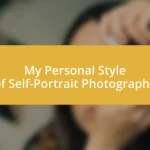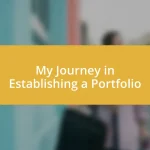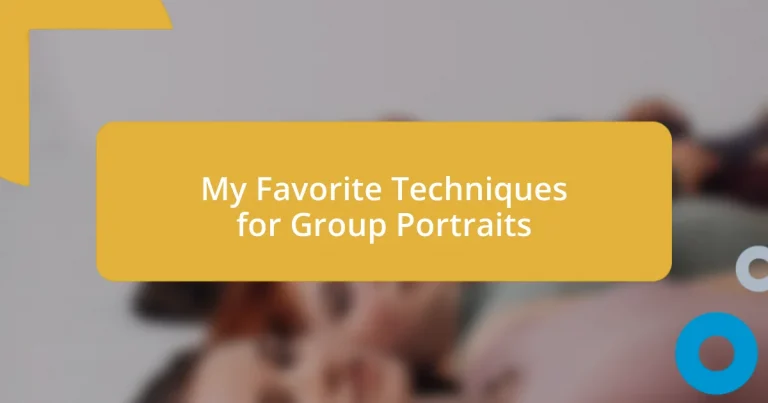Key takeaways:
- Understanding group dynamics and interactions is essential for capturing authentic moments in portrait photography.
- Effective planning, including location scouting and time management, ensures balanced compositions and memorable candid shots.
- Post-processing techniques, such as exposure adjustments and color correction, can significantly enhance the emotional impact and overall quality of group portraits.
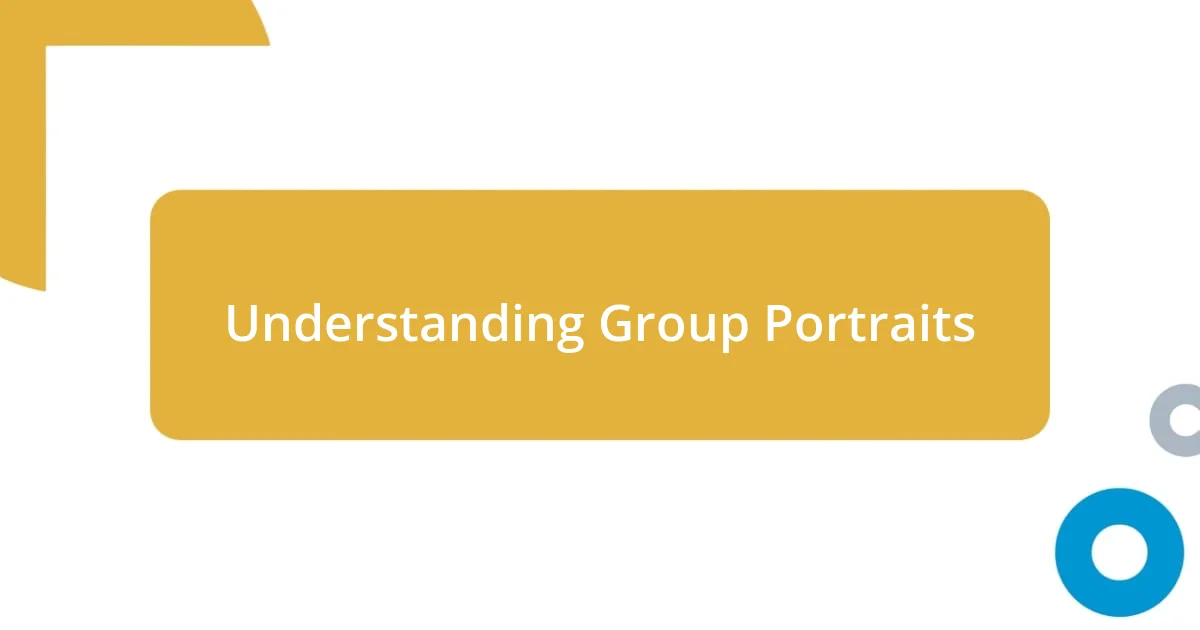
Understanding Group Portraits
Group portraits capture the essence of relationships among people, often reflecting a shared experience or a momentous occasion. I remember one time at a family reunion when I aimed to capture everyone’s unique personalities in just one frame. It was a challenge, yet seeing the joy and familiarity between my relatives made it all the more rewarding.
Understanding group dynamics is crucial in photography, especially in such portraits. Have you ever noticed how body language and positioning can shift the mood of a photo? I’ve experienced this firsthand; a slight adjustment in how individuals hold themselves can transform a static image into something full of energy and connection.
When photographing groups, it’s not just about who they are but how they interact. I often find myself observing the subtle exchanges—like a shared laugh or a knowing glance—before pressing the shutter. Those little moments reveal a deeper bond that transcends the physical image and resonate with the viewer on an emotional level.
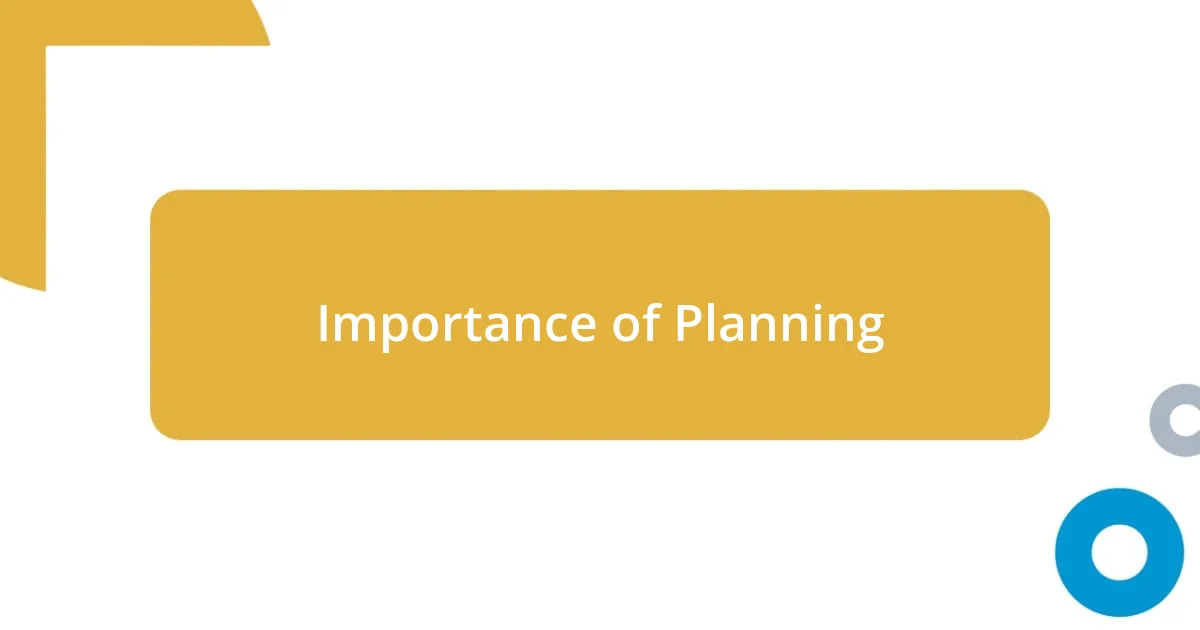
Importance of Planning
Planning is the backbone of a successful group portrait session. I learned this lesson the hard way during my first attempt at capturing my college friends. We gathered without a clear vision, leading to photos where some people appeared more prominent than others, overshadowing important connections. Establishing a detailed plan helps to ensure that everyone has their moment, creating a balanced composition that celebrates the group as a whole.
Before the shoot, I always scout the location and consider the lighting conditions. I remember one session at sunset, where the golden glow added warmth to our smiles. Without planning the timing, we could have missed that perfect moment. It’s about visualizing how light interacts with the scene, allowing me to set up not just the shot, but the entire mood of the gathering.
A well-structured plan also helps to manage time effectively. When I organized a family photoshoot for a milestone birthday, I drafted an agenda to include different poses and combinations. This not only kept the energy up but also allowed us to savor candid moments in between the planned shots. As a result, we ended up with so many wonderful memories, rather than just a few standard framed photos.
| Key Element | Impact |
|---|---|
| Clear Vision | Ensures balanced composition |
| Location Scouting | Maximizes lighting and mood |
| Time Management | Creates opportunity for candid moments |
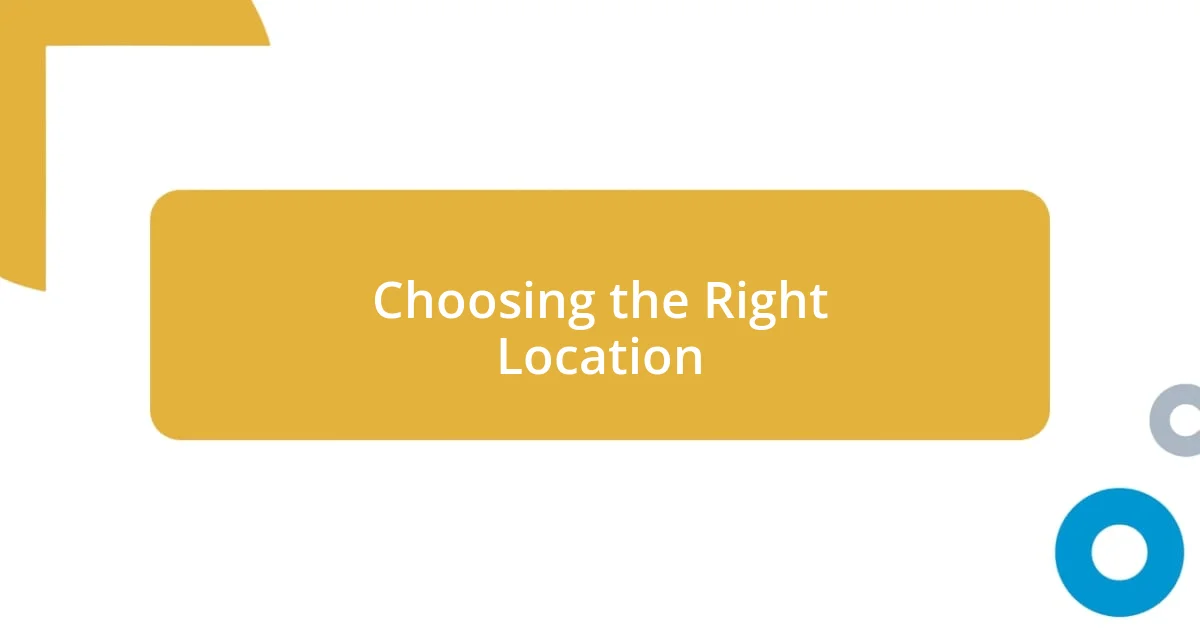
Choosing the Right Location
Choosing the right location for your group portraits can truly elevate the entire experience. I recall a delightful summer afternoon spent at a local park, where vibrant greenery provided a perfect backdrop. The laughter of children playing nearby added an organic warmth to our photos, capturing the candidness of the moment. When selecting a venue, I always seek places that resonate with the group’s personality, as this helps bring out genuine expressions.
Consider these factors when selecting a location for group portraits:
- Relevance: Choose a site that reflects the group’s interests or connection.
- Lighting: Natural light can enhance the mood; explore spots with soft, diffused sunlight.
- Space: Ensure there’s enough room for everyone to arrange comfortably without feeling cramped.
- Accessibility: Pick a location that is easy for all participants to reach, accommodating any mobility issues.
- Background: Look for backgrounds that add depth without distracting from the subjects.
Each location tells a story, and I’ve often found that the best spots are those where the group feels a sense of belonging. I once photographed a close-knit group of friends at their favorite café. The familiar environment allowed them to relax and engage with one another, resulting in genuinely heartfelt expressions. As I observed their interactions, I realized that capturing a group in a setting that resonates with their shared experiences can transform a simple photograph into a cherished memory. The essence of a group portrait lies not just in the people but also in the environment that surrounds them.
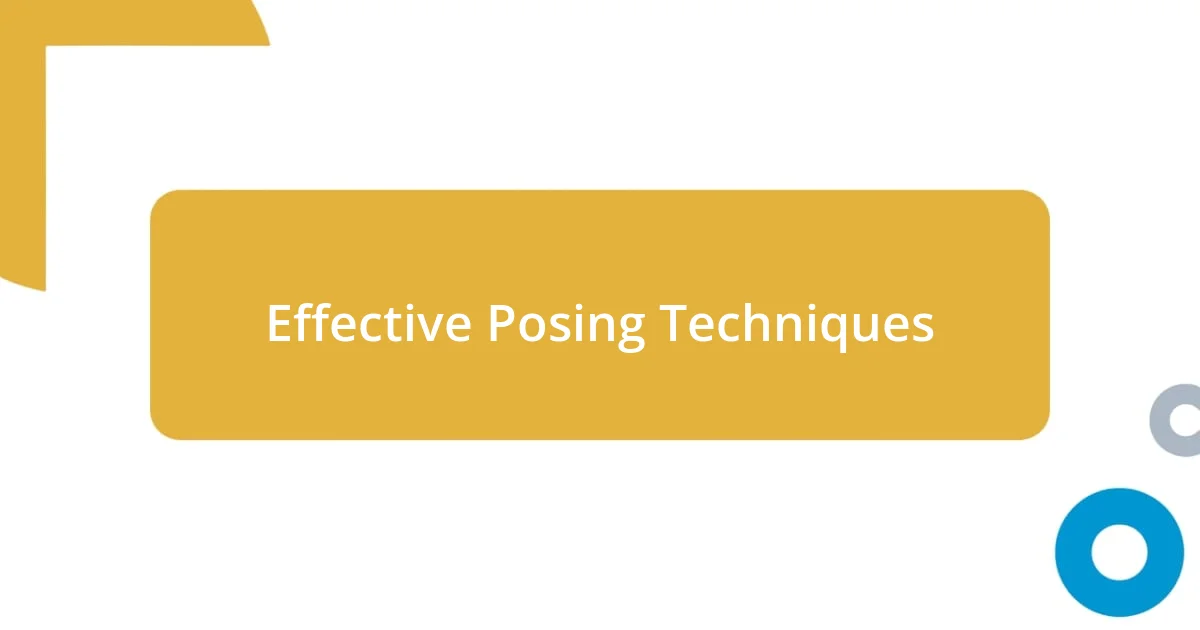
Effective Posing Techniques
Posing techniques can make a world of difference in group portraits. I always encourage groups to arrange themselves in a way that creates a natural flow, avoiding stiff formations. For instance, during a family reunion shoot, I suggested having everyone lean in slightly toward each other, which not only fostered a sense of closeness but also made for a more dynamic composition. Have you noticed how even slight variations in positioning can convey different moods in a photograph?
I often play with levels when arranging people. Elevation can add depth to the image—like when I elevated the youngest child on a grassy hill while the adults knelt. This not only created visual interest but also highlighted the child’s excitement. I’ve found that incorporating this technique can transform what might otherwise be a flat picture into something more engaging, don’t you think?
Another effective technique I rely on is to encourage movement during the session. I like to ask groups to interact, whether by exchanging funny stories or playfully nudging one another. During a recent shoot with some adventurous friends, their spontaneous bursts of laughter as they shared their inside jokes broke the ice beautifully. The resulting candid shots were bursting with life, much more memorable than posed smiles. Seeking movement often brings out authentic emotions, which ultimately leads to richer portraits.

Using Depth and Layers
Using depth and layers in group portraits can transform an otherwise flat image into a captivating visual story. I remember one particular shoot where I positioned a family on a stairway, allowing different heights to create a natural sense of depth. This simple layering not only drew the viewer’s eye through the image but also added context, making the photograph feel more dynamic than if everyone had stood in a straight line.
Playing with foreground and background elements is another way I like to create layers. For example, during a group gathering in a charming garden, I placed some members behind a flowering bush while others stood in front. This added dimension and context to the scene. When you look at such images, don’t you feel like you’re peeking into a lively moment? It invites the viewer to explore every aspect of the photo, which I find engaging.
The emotional resonance of depth and layers cannot be overstated. I once captured a group of close friends positioned with their backs against a rustic fence while leaners and sitters created a relaxed vibe. Their interaction with each other made the fence almost a character in itself, contributing to the overall mood. Layering isn’t just about aesthetics; it reflects relationships and connections, creating a richer narrative in the image. How often do you think about how these layers can enhance the emotional impact of your portraits?
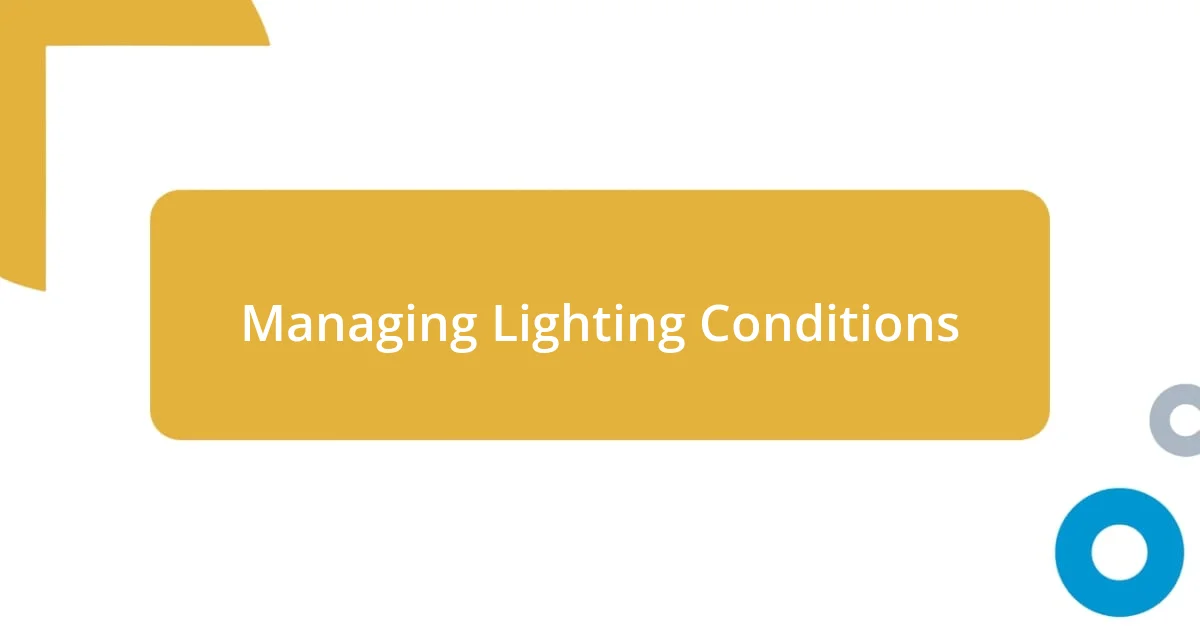
Managing Lighting Conditions
Managing lighting conditions in group portraits is crucial for capturing the perfect moment. I remember a shoot at sunset where the golden hour light bathed the group in a warm glow. It was magical—everyone’s expressions were beautifully illuminated, which transformed the mood of the photos completely. Have you ever noticed how lighting can shift the overall feeling of an image?
When shooting outdoors, I often assess the direction of the light. On one occasion, I was at a park with a large family, and I found a shaded area where the sunlight filtered through the trees. This soft lighting not only prevented harsh shadows on their faces but also created a whimsical, dappled effect that added character to the photos. I find that working with natural light can be very rewarding, don’t you agree?
In situations with challenging lighting, such as indoor gatherings, I’ve turned to reflectors or even portable flash units to fill in shadows. During a holiday party, I set up a simple reflector to bounce warm light back onto the group. This technique created a much more inviting atmosphere and enhanced the warmth of the moment. It’s fascinating how practical solutions can help me achieve that perfect shot, wouldn’t you say?
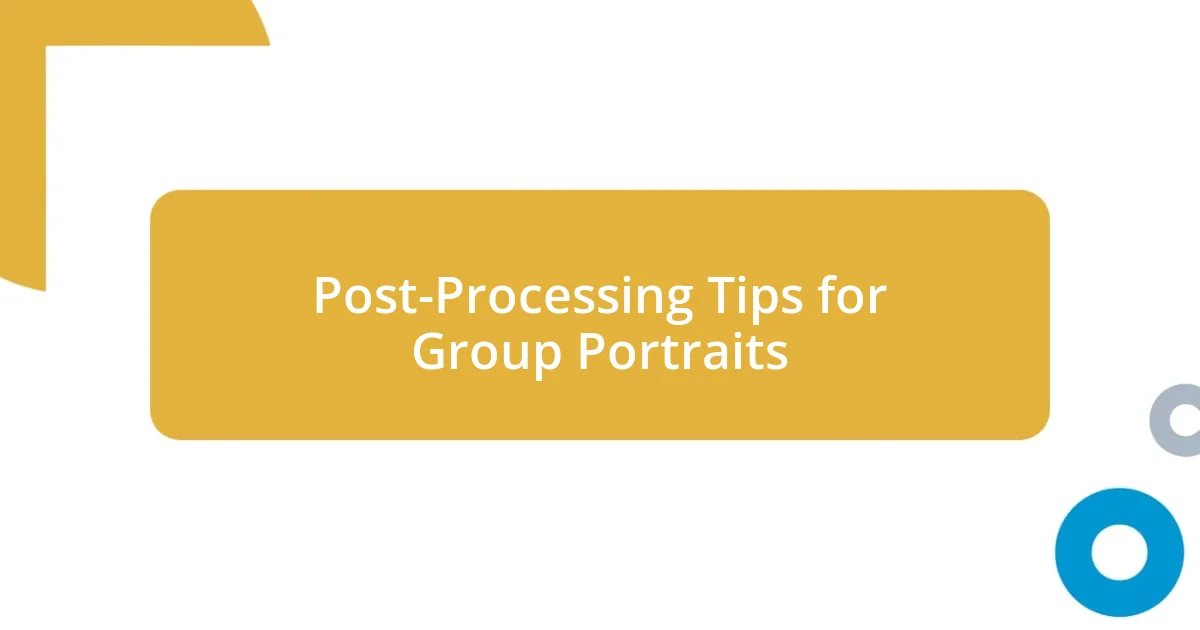
Post-Processing Tips for Group Portraits
Post-processing group portraits is where the magic truly happens. I often begin by adjusting the exposure and contrast to bring out the subtle details that might get lost, especially in larger groups. I remember a family portrait I edited where the back row was initially too dark. By fine-tuning the levels, I was able to highlight their expressions, making the entire image feel more cohesive and lively. Have you ever experienced how a slight adjustment can transform a photo?
Color correction is another essential aspect of my editing process. I recall a fun event where everyone wore brightly colored outfits, but the original shot had a bit of a washed-out look. By enhancing the saturation and vibrancy, I was able to emphasize those joyful colors, reflecting the spirit of the day. It’s amazing how the right hues can evoke emotions—doesn’t it feel like the photo jumps to life?
Finally, I find that using cropping strategically can enhance the composition dramatically. In one portrait session, I noticed that some group members on the edge felt disconnected from the rest. After cropping, the revised image centered the main subjects, creating a stronger connection and emphasis on their smiles and interactions. Isn’t it interesting how a little tweak can make relationships within the image feel more intimate?
